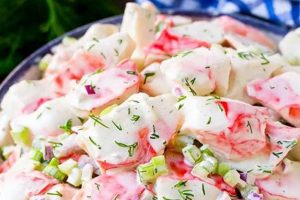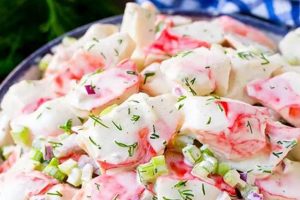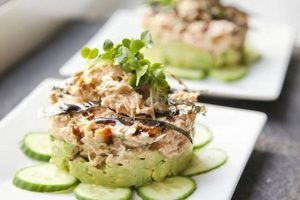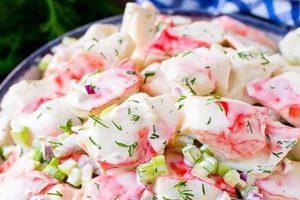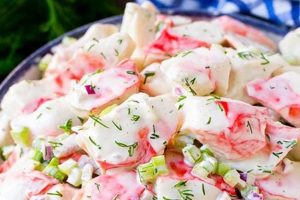A combination of cooked crab meat, mayonnaise, and seasonings, often including celery, onion, and mustard, forms the foundation of a spread ideal for sandwiches. Variations may incorporate ingredients such as lemon juice, Old Bay seasoning, dill, or hard-boiled eggs, offering a wide range of flavor profiles. This versatile mixture can be served chilled on various breads, rolls, or crackers.
This classic dish offers a convenient and flavorful way to enjoy seafood. Its adaptability makes it suitable for picnics, quick lunches, or more formal occasions. Historically, crab salad’s popularity has been linked to the accessibility of canned crab meat, making it an economical and readily available protein source. The ease of preparation further contributes to its enduring appeal, requiring minimal cooking and allowing for customization based on individual preferences and available ingredients.
Discussions regarding optimal crab species, mayonnaise choices, and complementary seasonings contribute to a deeper understanding of crafting this delectable spread. Exploring different bread options, serving suggestions, and potential variations expands the culinary possibilities.
Tips for Exceptional Crab Salad Sandwiches
Achieving optimal flavor and texture in crab salad sandwiches requires attention to several key factors. The following tips offer guidance for preparing a superior crab salad filling and assembling delicious sandwiches.
Tip 1: Select High-Quality Crab Meat: Opting for fresh, well-sourced crab meat, whether lump, claw, or backfin, significantly impacts the overall quality. Canned crab meat provides a convenient alternative but should be drained thoroughly to remove excess liquid.
Tip 2: Balance the Mayonnaise: Mayonnaise binds the ingredients and contributes richness, but excessive amounts can lead to a bland, overly creamy texture. Start with a smaller quantity and adjust according to preference.
Tip 3: Enhance Flavor with Seasonings: Classic additions such as Old Bay, Dijon mustard, and lemon juice elevate the crab’s natural sweetness. Fresh herbs like dill or parsley provide bright, complementary notes.
Tip 4: Optimize Texture with Vegetables: Finely diced celery and red onion offer a satisfying crunch and enhance the overall flavor profile. Consider incorporating other vegetables like bell peppers for added complexity.
Tip 5: Chill Thoroughly Before Serving: Allowing the crab salad to chill in the refrigerator for at least 30 minutes allows the flavors to meld and creates a more refreshing sandwich filling.
Tip 6: Choose the Right Bread: Soft, sturdy breads like brioche, croissants, or classic white bread complement the delicate crab salad. Toasted bread adds textural contrast.
Tip 7: Consider Garnishes and Accompaniments: Lettuce, tomato slices, or avocado enhance the sandwich’s visual appeal and add complementary flavors. Serving alongside potato chips or a light salad completes the meal.
By following these guidelines, one can elevate crab salad sandwiches from simple fare to a truly satisfying culinary experience. Careful ingredient selection, balanced seasonings, and proper chilling contribute to a flavorful and texturally pleasing outcome.
These tips represent a starting point for exploration and customization. Individual preferences and culinary creativity can further refine the preparation and presentation of this versatile dish.
1. High-quality Crab Meat
Crab meat quality significantly influences the overall sensory experience of a crab salad sandwich. Utilizing superior crab meat elevates the dish from simple fare to a culinary delight. Understanding the nuances of crab meat selection is crucial for achieving optimal flavor and texture.
- Species Selection:
Different crab species offer varying flavor profiles and textures. Jumbo lump crab meat, derived from the largest muscles of the blue crab, is prized for its delicate sweetness and substantial flakes. Claw meat, while less expensive, possesses a more assertive flavor and a slightly stringier texture. Backfin, a blend of smaller pieces, offers a balance of flavor and affordability. Species selection should align with individual preferences and budget considerations. For example, a special occasion sandwich might benefit from the premium quality of jumbo lump, while a casual lunch could utilize the more economical backfin.
- Freshness Indicators:
Fresh crab meat exhibits a bright, clean aroma reminiscent of the sea. Avoid crab meat with a fishy or ammonia-like odor, as this indicates spoilage. Visual cues, such as vibrant color and firm texture, further signify freshness. If using pasteurized crab meat, ensure the packaging is intact and the expiration date has not passed. Proper handling and storage are essential for maintaining quality.
- Impact on Flavor and Texture:
High-quality crab meat contributes a delicate sweetness and a satisfyingly flaky texture to the salad. Inferior crab meat can introduce undesirable flavors and a mushy consistency, detracting from the overall enjoyment. The quality of the crab meat directly impacts the final product. A sandwich made with fresh, succulent jumbo lump crab meat offers a luxurious experience, while one made with lower-quality meat may be less satisfying.
- Sourcing Considerations:
Supporting sustainable fisheries and responsible sourcing practices ensures the long-term availability of high-quality crab meat. Consumers can make informed choices by selecting crab meat from reputable suppliers who prioritize ethical harvesting methods and environmental stewardship. This not only benefits the ecosystem but also contributes to the availability of premium crab meat for future generations.
The selection of high-quality crab meat forms the foundation of an exceptional crab salad sandwich. Understanding the nuances of species, freshness, and sourcing enables informed decisions that elevate the overall culinary experience. By prioritizing quality, individuals can create a sandwich that truly showcases the delicate flavors and satisfying textures of this prized ingredient. The interplay between crab meat quality and other recipe components, such as seasonings and bread, ultimately determines the sandwich’s success.
2. Balanced Seasonings
Seasoning plays a pivotal role in crab salad recipes, transforming simple ingredients into a flavorful, cohesive filling. Achieving a balanced flavor profile requires careful consideration of complementary spices and seasonings that enhance, rather than overpower, the delicate sweetness of the crab meat. The interplay of various seasonings contributes to the overall complexity and enjoyment of the sandwich.
- Classic Combinations:
Traditional crab salad seasonings often include Old Bay, a blend of celery salt, paprika, black pepper, and other spices, which imparts a savory depth. Dijon mustard adds a tangy complexity, while lemon juice provides brightness and acidity. This classic trio offers a balanced foundation upon which further customization can be built. For example, a touch of cayenne pepper can introduce a subtle heat, while fresh dill provides a herbaceous counterpoint.
- Enhancing Sweetness:
The natural sweetness of crab meat can be accentuated with subtle additions of sugar or a pinch of nutmeg. These ingredients subtly amplify the inherent flavors without overpowering the delicate profile. However, restraint is crucial; excessive sweetness can create an unbalanced flavor profile, detracting from the overall experience.
- Balancing Saltiness:
Salt is essential for enhancing flavors, but over-salting can mask the delicate nuances of the crab. Careful monitoring of salt levels is crucial, especially when using ingredients like Old Bay seasoning, which contains salt. Tasting and adjusting throughout the preparation process ensures a harmonious balance. Additionally, using high-quality sea salt can contribute a cleaner, more nuanced salinity compared to standard table salt.
- Fresh Herbs and Aromatics:
Fresh herbs, such as dill, parsley, or chives, introduce vibrant, aromatic notes that complement the crab’s flavor. Incorporating finely minced shallots or red onion adds a subtle pungency and textural complexity. These additions should be used judiciously to avoid overpowering the primary flavors. The interplay of fresh herbs and aromatics creates a multi-layered sensory experience.
A well-seasoned crab salad elevates the sandwich from a simple combination of ingredients to a harmonious blend of flavors and textures. The careful balance of seasonings not only complements the crab but also enhances the other components, creating a unified and satisfying culinary experience. Achieving this balance is essential for crafting a truly exceptional crab salad sandwich.
3. Optimal Mayonnaise Ratio
Mayonnaise serves as a crucial binding agent and flavor enhancer in crab salad intended for sandwiches. However, the ratio of mayonnaise to other ingredients significantly impacts the final product’s texture, flavor, and overall appeal. A carefully considered mayonnaise proportion contributes to a balanced, enjoyable culinary experience.
- Texture and Consistency:
Excessive mayonnaise results in a loose, overly creamy filling that can make sandwich assembly challenging and lead to a soggy final product. Insufficient mayonnaise, conversely, yields a dry, crumbly mixture that lacks cohesion and flavor integration. The optimal ratio ensures a spreadable consistency that adheres well to bread without becoming overwhelming.
- Flavor Balance:
Mayonnaise contributes a rich, tangy flavor that complements the delicate sweetness of crab meat. However, an overabundance of mayonnaise can mask the subtle nuances of the crab and other seasonings. A balanced ratio allows the individual flavors to shine while creating a harmonious overall profile. For instance, a crab salad featuring prominent citrus notes might necessitate less mayonnaise to preserve the intended brightness.
- Visual Appeal:
The mayonnaise content directly influences the visual presentation of the crab salad. Too much mayonnaise creates a pale, homogenous appearance, while too little results in a dry, unappetizing look. The ideal ratio yields a visually appealing filling with a creamy texture and discernible chunks of crab and other ingredients.
- Recipe Adjustments:
Adjusting the mayonnaise quantity may be necessary depending on the other ingredients and desired outcome. Recipes incorporating ingredients with higher moisture content, such as chopped celery or diced bell peppers, may require less mayonnaise to maintain the desired consistency. Similarly, personal preferences regarding creaminess should be considered when determining the appropriate ratio.
Achieving the optimal mayonnaise ratio is essential for crafting a crab salad that delivers a satisfying sensory experience. Careful consideration of texture, flavor balance, and visual appeal allows for a customized approach that elevates the humble crab salad sandwich to a culinary triumph. A well-balanced mayonnaise proportion ensures that all components harmonize, creating a truly enjoyable dish.
4. Fresh, Crisp Vegetables
Fresh, crisp vegetables play a crucial role in crab salad sandwiches, contributing not only textural contrast but also enhancing the overall flavor profile. Their inclusion elevates the sandwich beyond a simple protein and mayonnaise combination, adding layers of complexity and freshness. The careful selection and preparation of these vegetables significantly influence the final product’s quality and appeal. For instance, finely diced celery provides a refreshing crunch and subtle vegetal notes that complement the sweetness of the crab. Similarly, thinly sliced red onion introduces a mild pungency and vibrant color, enhancing both the flavor and visual presentation.
The structural integrity of crisp vegetables maintains the desired texture within the sandwich. Unlike softer vegetables that might release excess moisture and contribute to a soggy filling, crisp vegetables retain their form and contribute to a more enjoyable eating experience. This textural contrast is particularly important when using softer breads, such as brioche or croissants, where structural integrity is crucial. The interplay of textures between the soft bread, creamy filling, and crisp vegetables creates a balanced and satisfying sensory experience. Consider a sandwich featuring crisp diced cucumber and bell peppers alongside the crab salad; these elements provide a refreshing counterpoint to the richness of the mayonnaise and crab, contributing to a more dynamic and enjoyable meal.
Integrating fresh, crisp vegetables into crab salad offers a platform for culinary creativity and customization. While celery and red onion remain classic choices, other options, such as finely chopped fennel, water chestnuts, or jicama, can introduce unique flavors and textures. Exploring seasonal vegetables allows for variations that reflect the time of year and offer a fresh perspective on this classic dish. Furthermore, utilizing fresh, high-quality vegetables aligns with health-conscious preferences, adding nutritional value to the sandwich. The judicious selection and incorporation of fresh, crisp vegetables elevates the crab salad sandwich from simple fare to a culinary creation that balances flavor, texture, and visual appeal.
5. Appropriate Bread Choice
Bread selection significantly impacts the overall enjoyment of a crab salad sandwich. The bread acts as both a structural foundation and a flavor component, influencing the sandwich’s texture, taste, and ease of consumption. Compatibility between the bread and the crab salad filling is paramount. A sturdy bread capable of supporting the filling without becoming soggy is essential. Flavor profiles should complement rather than compete with the delicate crab salad. For example, a robust sourdough might overpower the subtle flavors of the crab, while a soft, buttery brioche enhances the richness and sweetness.
Practical considerations further underscore the importance of appropriate bread choice. Sandwich size and intended serving style influence bread selection. Sliced sandwich loaves offer versatility for both individual servings and larger presentations. Rolls, such as croissants or Kaiser rolls, provide a more substantial, handheld option. For smaller, appetizer-sized portions, crackers or mini toasts offer delicate platforms for the crab salad. The structural integrity of the bread also affects portability and ease of handling. A delicate bread might crumble easily, making it unsuitable for picnics or packed lunches. Conversely, a sturdy roll maintains its shape and prevents spillage, making it ideal for on-the-go consumption.
Careful bread selection elevates the crab salad sandwich from a simple meal to a cohesive culinary experience. The interplay of textures and flavors between the bread and the filling creates a harmonious balance. Considering factors such as structural integrity, flavor compatibility, and intended serving style ensures a satisfying and enjoyable outcome. Ultimately, the appropriate bread choice complements and enhances the delicate flavors of the crab salad, creating a truly delightful culinary composition.
Frequently Asked Questions
Addressing common inquiries regarding crab salad for sandwiches provides clarity and guidance for optimal preparation and enjoyment. The following questions and answers offer practical insights and address potential concerns.
Question 1: What type of crab meat is best suited for crab salad sandwiches?
While various crab meat types can be utilized, lump crab meat is generally preferred for its delicate flavor and large flakes. Claw meat offers a more economical option, while backfin provides a balance of flavor and affordability. The choice ultimately depends on individual preferences and budget considerations.
Question 2: How can one prevent crab salad from becoming watery?
Excess moisture can stem from several sources, including insufficiently drained canned crab meat or watery vegetables. Thoroughly draining all ingredients before combining them is crucial. Adjusting the mayonnaise quantity can further help achieve the desired consistency.
Question 3: What are the key seasonings that complement crab meat?
Classic seasonings include Old Bay, Dijon mustard, lemon juice, and fresh dill. These ingredients enhance the natural sweetness of the crab while adding depth and complexity. Experimentation with other spices and herbs can further personalize the flavor profile.
Question 4: How long can crab salad be stored in the refrigerator?
Properly stored in an airtight container, crab salad typically remains safe to consume for up to three days in the refrigerator. However, consuming it within 24 hours is recommended for optimal flavor and freshness.
Question 5: What types of bread are recommended for crab salad sandwiches?
Sturdy breads like brioche, croissants, or classic white bread provide a suitable foundation for crab salad. Toasted bread adds textural contrast. The choice depends on individual preferences and desired serving style.
Question 6: Can crab salad be frozen?
Freezing crab salad is generally not recommended, as the mayonnaise base can separate upon thawing, resulting in an undesirable texture. It is best to prepare and consume crab salad fresh for optimal quality.
Understanding these key aspects of crab salad preparation ensures a satisfying culinary experience. Careful consideration of ingredients, seasonings, and storage practices contributes to a delicious and enjoyable sandwich.
This information serves as a foundation for further exploration of crab salad variations and culinary applications. Experimentation with different ingredients and seasonings allows for personalized flavor profiles and customized culinary creations.
Crab Salad Recipe for Sandwiches
Exploration of crab salad recipes for sandwiches reveals the critical interplay of ingredients, preparation techniques, and presentation. High-quality crab meat, balanced seasonings, optimal mayonnaise ratios, fresh vegetables, and appropriate bread choices collectively contribute to a superior culinary experience. Understanding these elements allows for informed decisions regarding ingredient selection, flavor profiles, and textural nuances. Attention to detail, from proper chilling techniques to thoughtful bread pairings, elevates this seemingly simple dish to a culinary achievement.
Culinary exploration extends beyond established guidelines. Individual preferences and creative adaptations further refine crab salad preparation, offering a canvas for personalized flavor profiles and innovative presentations. The enduring appeal of crab salad sandwiches lies in their adaptability and potential for culinary expression. Continued experimentation promises further evolution and refinement of this classic dish.

